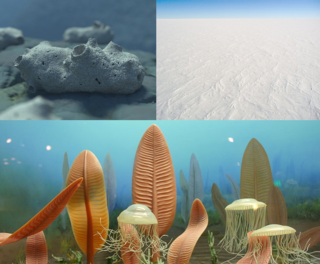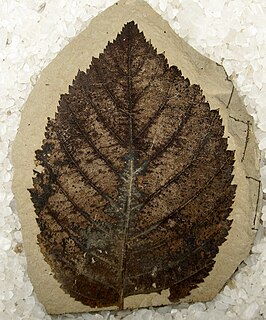
A fossil is any preserved remains, impression, or trace of any once-living thing from a past geological age. Examples include bones, shells, exoskeletons, stone imprints of animals or microbes, objects preserved in amber, hair, petrified wood, oil, coal, and DNA remnants. The totality of fossils is known as the fossil record.

The Neoproterozoic Era is the unit of geologic time from 1 billion to 538.8 million years ago.

Orrorin tugenensis is a postulated early species of Homininae, estimated at 6.1 to 5.7 million years ago and discovered in 2000. It is not confirmed how Orrorin is related to modern humans. Its discovery was used to argue against the hypothesis that australopithecines are human ancestors, although this remains the most prevalent hypothesis of human evolution as of 2012.

Paleontology, also spelled palaeontology or palæontology, is the scientific study of life that existed prior to, and sometimes including, the start of the Holocene epoch. It includes the study of fossils to classify organisms and study their interactions with each other and their environments. Paleontological observations have been documented as far back as the 5th century BCE. The science became established in the 18th century as a result of Georges Cuvier's work on comparative anatomy, and developed rapidly in the 19th century. The term itself originates from Greek παλα, ὄν, and λόγος.

Mary Anning was an English fossil collector, dealer, and palaeontologist who became known around the world for the discoveries she made in Jurassic marine fossil beds in the cliffs along the English Channel at Lyme Regis in the county of Dorset in Southwest England. Anning's findings contributed to changes in scientific thinking about prehistoric life and the history of the Earth.

Trilobites are extinct marine arthropods that form the class Trilobita. Trilobites form one of the earliest-known groups of arthropods. The first appearance of trilobites in the fossil record defines the base of the Atdabanian stage of the Early Cambrian period and they flourished throughout the lower Paleozoic before slipping into a long decline, when, during the Devonian, all trilobite orders except the Proetida died out. The last extant trilobites finally disappeared in the mass extinction at the end of the Permian about 252 million years ago. Trilobites were among the most successful of all early animals, existing in oceans for almost 270 million years, with over 20,000 species having been described.

Ammonoids are a group of extinct marine mollusc animals in the subclass Ammonoidea of the class Cephalopoda. These molluscs, commonly referred to as ammonites, are more closely related to living coleoids than they are to shelled nautiloids such as the living Nautilus species. The earliest ammonites appeared during the Devonian, and the last species either vanished in the Cretaceous–Paleogene extinction event, or shortly after, during the Danian epoch of the Paleocene.

Paleobotany, which is also spelled as palaeobotany, is the branch of botany dealing with the recovery and identification of plant remains from geological contexts, and their use for the biological reconstruction of past environments (paleogeography), and the evolutionary history of plants, with a bearing upon the evolution of life in general. A synonym is paleophytology. It is a component of paleontology and paleobiology. The prefix palaeo- means "ancient, old", and is derived from the Greek adjective παλαιός, palaios. Paleobotany includes the study of terrestrial plant fossils, as well as the study of prehistoric marine photoautotrophs, such as photosynthetic algae, seaweeds or kelp. A closely related field is palynology, which is the study of fossilized and extant spores and pollen.

Homo is the genus that emerged in the genus Australopithecus that encompasses the extant species Homo sapiens, plus several extinct species classified as either ancestral to or closely related to modern humans, most notably Homo erectus and Homo neanderthalensis. The genus emerged with the appearance of Homo habilis just over 2 million years ago. Homo, together with the genus Paranthropus, is probably sister to Australopithecus africanus, which itself had previously split from the lineage of Pan, the chimpanzees.

The Cradle of Humankind is a paleoanthropological site and is located about 50 km (31 mi) northwest of Johannesburg, South Africa, in the Gauteng province. Declared a World Heritage Site by UNESCO in 1999, the site currently occupies 47,000 hectares (180 sq mi) and contains a complex system of limestone caves. The registered name of the site in the list of World Heritage Sites is Fossil Hominid Sites of South Africa.
Driftwood Canyon Provincial Park is a provincial park in British Columbia, Canada. Driftwood Canyon Provincial Park covers 23 ha of the Bulkley River Valley, on the east side of Driftwood Creek, a tributary of the Bulkley River, 10 km northeast of the town of Smithers. The park is accessible from Driftwood Road from Provincial Highway 16. It was created in 1967 by the donation of the land by the late Gordon Harvey (1913–1976) to protect fossil beds on the east side of Driftwood Creek. The beds were discovered around the beginning of the 20th century. The park lands are part of the asserted traditional territory of the Wet'suwet'en First Nation.
Banksia strahanensis is an extinct species of tree or shrub in the plant genus Banksia. It is known only from a fossil leaf and several fossil leaf fragments found in Early to Middle Pleistocene sediment at Regatta Point in western Tasmania. These are long and very narrow, with entire margins, superficially resembling leaves of the extant B. spinulosa.

The history of paleontology traces the history of the effort to understand the history of life on Earth by studying the fossil record left behind by living organisms. Since it is concerned with understanding living organisms of the past, paleontology can be considered to be a field of biology, but its historical development has been closely tied to geology and the effort to understand the history of Earth itself.

Jebel Irhoud or Adrar n Ighoud, is an archaeological site located just north of the locality known as Tlet Ighoud, approximately 50 km (30 mi) south-east of the city of Safi in Morocco. It is noted for the hominin fossils that have been found there since the discovery of the site in 1960. Originally thought to be Neanderthals, the specimens have since been assigned to Homo sapiens or Homo helmei and, as reported in 2017, have been dated to roughly 300,000 years ago.

The Ediacaranbiota is a taxonomic period classification that consists of all life forms that were present on Earth during the Ediacaran Period. These were composed of enigmatic tubular and frond-shaped, mostly sessile, organisms. Trace fossils of these organisms have been found worldwide, and represent the earliest known complex multicellular organisms.

Panphagia is a genus of sauropodomorph dinosaur described in 2009. It lived around 231 million years ago, during the Carnian age of the Late Triassic period in what is now northwestern Argentina. Fossils of the genus were found in the La Peña Member of the Ischigualasto Formation in the Ischigualasto-Villa Unión Basin. The name Panphagia comes from the Greek words pan, meaning "all", and phagein, meaning "to eat", in reference to its inferred omnivorous diet. Panphagia is one of the earliest known dinosaurs, and is an important find which may mark the transition of diet in early sauropodomorph dinosaurs.

The Salientia are a total group of amphibians that includes the order Anura, the frogs and toads, and various extinct proto-frogs that are more closely related to the frogs than they are to the Urodela, the salamanders and newts. The oldest fossil "proto-frog" appeared in the early Triassic of Madagascar, but molecular clock dating suggests their origins may extend further back to the Permian, 265 million years ago.
Australornis is a genus of extinct seabird discovered in New Zealand. It lived in the Paleocene epoch, 60.5 to 61.6 million years ago (Ma). The type species name originates from australis, Latin for "southern", and ornis, the Greek word for "bird", and lovei commemorates Leigh Love, an amateur paleontologist who discovered it.

The Dmanisi hominins, Dmanisi people or Dmanisi man were a population of Early Pleistocene hominins whose fossils have been recovered at Dmanisi, Georgia. The fossils and stone tools recovered at Dmanisi range in age from 1.85–1.77 million years old, making the Dmanisi hominins the earliest well-dated hominin fossils in Eurasia and the best preserved fossils of early Homo from a single site so early in time, though earlier fossils and artifacts have been found in Asia. Though their precise classification is controversial and disputed, the Dmanisi fossils are highly significant within research on early hominin migrations out of Africa. The Dmanisi hominins are known from over a hundred postcranial fossils and five famous well-preserved skulls, referred to as Dmanisi Skulls 1–5.
The Apidima Cave is a complex of four small caves located on the western shore of Mani Peninsula in Southern Greece. A systematic investigation of the cave has yielded Neanderthal and Homo sapiens fossils from the Palaeolithic era.















